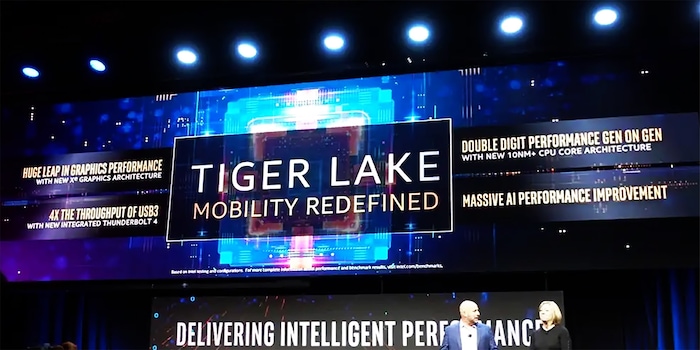
11. Generation Mobile Intel Core processors
The eleventh mobile Core-i generation has arrived. Intel has introduced seven new processors. The first end devices with Tiger-Lake chips are expected to release in just a few weeks and are keeping competitor AMD at bay.
To start off its eleventh generation, Intel is presenting three i7, two i5 and two i3 SoCs. The new mobile processors have a power consumption that can be configured by the manufacturer, which is why Intel doesn't specify a nominal TDP value, but a TDP down and TDP up value. They can be recognized by the «0» or «5» in front of the «G» in the processor number. With 0, the TDP is between 7 and 15 watts. With a 5, it's 12 to 28 watts. Of course, the given basic clock rate also depends on the configured TDP or the cooling of the end device and scales accordingly.
| Model | Cores and threads | TDP | Base frequency | Max. turbo frequency | Cache |
|---|---|---|---|---|---|
| Core i7-1185G7 | 4 cores, 8 threads | 12-28 W | 1,2-3,0 GHz | 4,8 GHz | 12 MB |
| Core i7-1165G7 | 4 cores, 8 threads | 12-28 W | 1,2-2,8 GHz | 4,7 GHz | 12 MB |
| Core i7-1160G7 | 4 cores, 8 threads | 7-15 W | 0,9-2,1 GHz | 4,4 GHz | 12 MB |
| Core i5-1135G7 | 4 cores, 8 threads | 12-28 W | 0,9-2,4 GHz | 4,2 GHz | 8 MB |
| Core i5-1130G7 | 4 cores, 8 threads | 7-15 W | 0,8-1,8 GHz | 4,0 Ghz | 8 MB |
| Core i3-1115G4 | 2 cores, 4 threads | 12-28 W | 1,7-3,0 GHz | 4,1 GHz | 6 MB |
| Core i3-1110G4 | 2 cores, 4 threads | 7-15 W | 1,5-2,5 GHz | 3,9 GHz | 6 MB |
The Core i3 SoC has two cores, all others have four. i3 variants have a 6 MB CPU cache, the i5 has 8 MB and the i7 has 12 MB. Furthermore, the chips manufactured in the 10 nm Super Fin process have, among other things, an L2 cache of 1.25 MB per core. They also support Thunderbolt 4 – this way they're also prepared for USB 4 – and offer PCIe 4.0. For the first time, an integrated AI engine will also provide support, for example for video calls.
In order to be able to control 8K monitors, the new integrated Iris-XE-GPU provides more power. This is used in the i5 and i7 models, offering 96 and 80 execution units respectively. The turbo clock of the new XE graphics architecture is between 1.1 and 1.35 GHz depending on the TDP. According to Intel's tests, the Iris Xe GPU of an i7-1185G7 used in the racing game Grid manages to reach around 60 FPS in Full HD resolution – a similar system with the AMD Ryzen 7 4800U should only achieve around 35 FPS.
Compared to the tenth generation Ice Lake, the new Tiger Lake processors intended for ultrabooks don't only benefit from better manufacturing. Above all, the revised graphics unit and the faster Thunderbolt 4 interface should keep Intel near the top of the mobile processors. AMD recently turned the market upside down with its Ryzen 4000 mobile processors. Above all, AMD could score points thanks to the Vega graphics unit. It's much more powerful than the Intel Iris. Xe is supposed to change all this. Since there are no independent benchmarks for the processors so far, we can be curious about the exact performance. The first devices with eleventh generation Intel processors are expected to release in a few weeks.
I find my muse in everything. When I don’t, I draw inspiration from daydreaming. After all, if you dream, you don’t sleep through life.